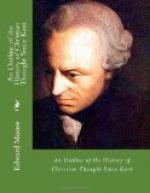Ferdinand Christian Baur was born in 1793 in Schmieden, near Stuttgart. He became a professor in Tuebingen in 1826 and died there in 1860. He was an ardent disciple of Hegel. His greatest work was surely in the field of the history of dogma. His works, Die Christliche Lehre von der Vereoehnung, 1838, Die Christliche Lehre von der Dreieinigkeit und Menschwerdung Gottes, 1841-1843, his Lehrbuch der Christlichen Dogmengeschichte, 1847, together constitute a contribution to which Harnack’s work in our own time alone furnishes a parallel. Baur had begun his thorough biblical studies before the publication of Strauss’ book. The direction of those studies was more than ever confirmed by his insight of the shortcomings of Strauss’ work. Very characteristically also he had begun his investigations, not at the most difficult point, that of the Gospels, as Strauss had done, but at the easiest point, the Epistles of Paul. As early as 1831 he had published a tractate, Die Christus-Partei in der Corinthischen Gemeinde. In that book he had delineated the bitter contest between Paul and the Judaising element in the Apostolic Church which opposed Paul whithersoever he went. In 1835 his disquisition, Die sogenannten Pastoral-Briefe, appeared. In the teachings of these letters he discovered the antithesis to the gnostic heresies of the second century. He thought also that the stage of organisation of the Church which they imply, accorded better with this supposition than with that of their apostolic authorship. The same general theme is treated in a much larger way in Baur’s Paulus, der Apostel Jesu Christi, in 1845. Here the results of his study of the book of the Acts are combined with those of his inquiries as to the Pauline Epistles. In the history of the apostolic age men had been accustomed to see the evidence only of peace and harmony. Baur sought to show that the period had been one of fierce struggle, between the narrow Judaic and legalistic form of faith in the Messiah and that conception, introduced by Paul, of a world-religion free from the law. Out of this conflict, which lasted a hundred and fifty years, went forth the Catholic Church. The monuments of this struggle and witnesses of this process of growth are the New Testament writings, most of which were produced in the second century. The only documents which we have which were written before A.D. 70, were the four great Epistles of Paul, those to the Galatians, to the Romans, and to the Corinthians, together with the Apocalypse.




